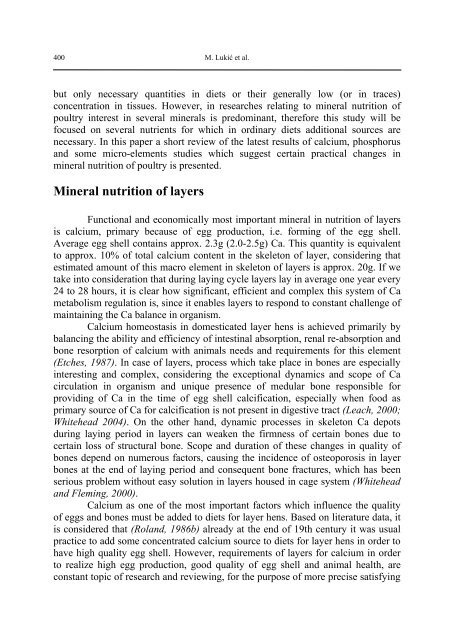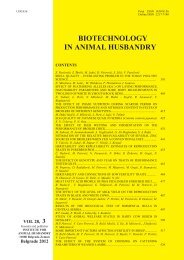MINERAL NUTRITION OF MODERN POULTRY ... - doiSerbia
MINERAL NUTRITION OF MODERN POULTRY ... - doiSerbia
MINERAL NUTRITION OF MODERN POULTRY ... - doiSerbia
Create successful ePaper yourself
Turn your PDF publications into a flip-book with our unique Google optimized e-Paper software.
400<br />
M. Lukić et al.<br />
but only necessary quantities in diets or their generally low (or in traces)<br />
concentration in tissues. However, in researches relating to mineral nutrition of<br />
poultry interest in several minerals is predominant, therefore this study will be<br />
focused on several nutrients for which in ordinary diets additional sources are<br />
necessary. In this paper a short review of the latest results of calcium, phosphorus<br />
and some micro-elements studies which suggest certain practical changes in<br />
mineral nutrition of poultry is presented.<br />
Mineral nutrition of layers<br />
Functional and economically most important mineral in nutrition of layers<br />
is calcium, primary because of egg production, i.e. forming of the egg shell.<br />
Average egg shell contains approx. 2.3g (2.0-2.5g) Ca. This quantity is equivalent<br />
to approx. 10% of total calcium content in the skeleton of layer, considering that<br />
estimated amount of this macro element in skeleton of layers is approx. 20g. If we<br />
take into consideration that during laying cycle layers lay in average one year every<br />
24 to 28 hours, it is clear how significant, efficient and complex this system of Ca<br />
metabolism regulation is, since it enables layers to respond to constant challenge of<br />
maintaining the Ca balance in organism.<br />
Calcium homeostasis in domesticated layer hens is achieved primarily by<br />
balancing the ability and efficiency of intestinal absorption, renal re-absorption and<br />
bone resorption of calcium with animals needs and requirements for this element<br />
(Etches, 1987). In case of layers, process which take place in bones are especially<br />
interesting and complex, considering the exceptional dynamics and scope of Ca<br />
circulation in organism and unique presence of medular bone responsible for<br />
providing of Ca in the time of egg shell calcification, especially when food as<br />
primary source of Ca for calcification is not present in digestive tract (Leach, 2000;<br />
Whitehead 2004). On the other hand, dynamic processes in skeleton Ca depots<br />
during laying period in layers can weaken the firmness of certain bones due to<br />
certain loss of structural bone. Scope and duration of these changes in quality of<br />
bones depend on numerous factors, causing the incidence of osteoporosis in layer<br />
bones at the end of laying period and consequent bone fractures, which has been<br />
serious problem without easy solution in layers housed in cage system (Whitehead<br />
and Fleming, 2000).<br />
Calcium as one of the most important factors which influence the quality<br />
of eggs and bones must be added to diets for layer hens. Based on literature data, it<br />
is considered that (Roland, 1986b) already at the end of 19th century it was usual<br />
practice to add some concentrated calcium source to diets for layer hens in order to<br />
have high quality egg shell. However, requirements of layers for calcium in order<br />
to realize high egg production, good quality of egg shell and animal health, are<br />
constant topic of research and reviewing, for the purpose of more precise satisfying




